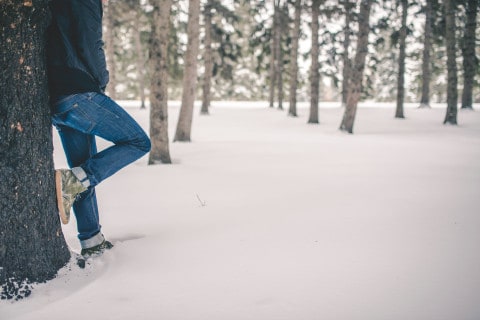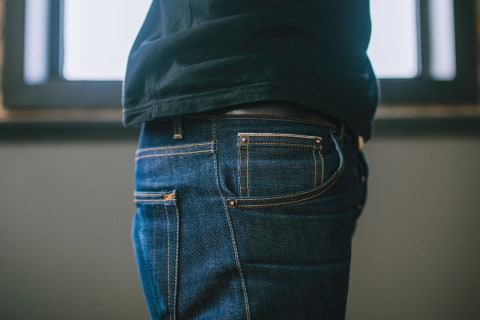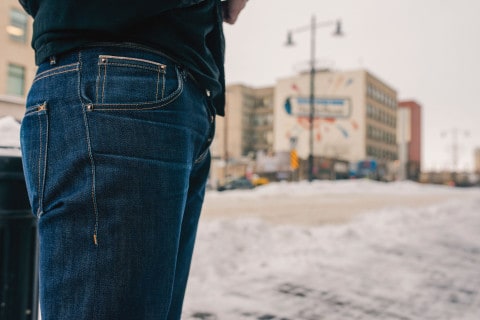ESB graduates Ryan Mack and Dallas Siemens unveil raw denim company
First heard echoing through the bullfighting rings of Spain in the late 1700s and popularized in soccer culture in the 1980s, the word “olé” is a universal expression of triumph and jubilation — which is exactly how Ryan Mack and Dallas Siemens see their jeans.
“‘Olé’ is the expression of joy, the celebration of life. It’s what we feel and how we want other people to feel when they put on our jeans,” said Siemens, co-founder of Olé Denim.
Alongside Winnipeg-based graphic designer Chris Watchorn, Siemens and Mack are the men behind Saskatoon’s newest denim brand, Olé. Founded in 2013, Olé began as a pet project between friends and has since grown to become the only company of it’s kind in Saskatchewan.
“About two years ago, when we were in our fourth year of school, we wanted to pick up a project,” said Mack. “We wanted to try something special to us, so we came up with the idea of making
jeans.”
Though born and designed on the Canadian prairies, Olé Denim’s unique products are sourced and manufactured internationally. Their jeans start their journey at the Kuroki denim factory in Okayama, Japan, where the finest denim is chosen before being flown to Los Angeles where they are ethically manufactured and made ready to wear.
 Despite being a small part of the already niche raw denim market, Olé sets itself apart from its competitors through the sheer dedication and attention to detail that Mack, Siemens and Watchorn put into every pair of jeans they produce. From the intricate process through which the denim is woven and dyed to the finishing touches such as the hand-made and stamped leather patches created by leather artisan Ken Diamond in Vancouver, Olé jeans are truly a work of art.
Despite being a small part of the already niche raw denim market, Olé sets itself apart from its competitors through the sheer dedication and attention to detail that Mack, Siemens and Watchorn put into every pair of jeans they produce. From the intricate process through which the denim is woven and dyed to the finishing touches such as the hand-made and stamped leather patches created by leather artisan Ken Diamond in Vancouver, Olé jeans are truly a work of art.
“We’re not some big company trying to mass-produce. We’re going for a heritage feel,” said Mack.
The Japanese raw denim that goes into every Olé product made in Okayama is rope-dyed, which involves gathering and twisting the fabric into ropes and then dipping it into indigo ink. This process prevents the ink from being fully absorbed into the fabric, allowing for that fashionably “faded” look to be achieved much more easily. The fabric itself is woven on a vintage shuttle loom, which results in the white selvage ends along the seams of the jeans that prevent them from unraveling or fraying. Vintage looms were used up until the 1950s when many manufacturers switched to projectile looms which are capable of producing denim more quickly using less fabric.
The jeans also go through the process of sanforization, which refers to the treatment and stretching of fabrics before they are cut in order to stop them from shrinking after being washed.
“A lot of these machines and processes [in Japan] have come from the late 1990s and are passed down in families,” said Mack. “Much of the equipment they use is traditional and isn’t made anymore, so this way you’re able to get a look and quality from the past.”
Olé Denim’s first line, affectionately dubbed the 306, will be released this spring and will offer customers a choice between the more common 13-ounce jean or the heavier and more winter-friendly 15-ounce jean.
Female fans of raw denim will have to wait to try on their first pair of Olé jeans, as the 306 line will be limited to men’s fashions.
“We really want to master the jean itself, the men’s jean, before we even consider women’s jeans or even just different products,” said Mack. “If you think about a restaurant — they have to practice hammering out that one specialty dish because everyone wants it.”
Though Mack, Siemens and Watchorn have found the perfect fit for their first line, it wasn’t always an easy road getting here.
“The first [sample] we made was weird. It was super dad-jean,” said Mack. “I was so excited, then I put them on and I remember being so upset.”
“Have you ever seen the show How To Make It In America? There’s one episode where they get their first pair of [sample jeans] and they fit completely weird and high-waisted. The same thing happened to us. They were really baggy and just terrible,” added Siemens.
Undeterred by this initial disappointment, the trio pressed on and after two years of development it seems they have finally created what they initially set out to — a pair of jeans that are as functional and comfortable as they are fashionable.
“It’s a basic jean… there’s not a lot of frills or pocket designs,” said Siemens. “We put a lot of effort into the manufacturing quality, whereas other basic jeans you can get for a lot cheaper — but that shows in the manufacturing. For me it’s the best basic you can get.”
Olé Denim strives to provide the wearer with a high-quality blank canvas that they can customize according to their taste and lifestyle. The 15-ounce jean in particular allows for a high degree of specialization because it is made up of what is referred to as “slubby” denim, or denim in which inconsistencies in the fabric are present due to the fact that it is produced on a vintage shuttle loom.
“Slubby” denim was initially viewed as being riddled with flaws due to the unevenness of the yarn, but Japanese designers have since come to embrace these subtle imperfections and intentionally add them to their jeans to give them more character.
“The Japanese see these different imperfections as being beautiful,” said Mack.
This innovative way of looking at denim production is the reason why Olé chose Japan as the source for their fabrics. The three-person company hopes to redefine the way that people in both Canada and the world think of fashion in the prairies.
“When you think of fashion, you probably think of New York, Los Angeles, Vancouver and Toronto,” said Siemens. “But we really want to show that the prairies can be a part of that as well. We’re proud of our roots and we want to showcase that.”
The Olé brand’s prairie origins are evident in the rugged simplicity of their products. Their jeans wouldn’t be out of place in a business setting or a backwoods cookout and their timeless blue hues match everything from casual t-shirts to formal button-downs.
This versatility and possibility for customization is exactly what Mack was hoping for when Olé’s first line went into production.
“If you’re going to bike in them, then [your jeans] will stress quicker than the dude that just sits around all day watching TV,” he said. “Everyone has their own story and everyone can make them special.”
The most appealing quality of raw denim undoubtedly lies in the opportunity for personalization. Factors as small as frequency of washing and activeness of lifestyle can turn the same basic pair of jeans into two wholly different creations when worn by two different people.
“Raw denim is special because people view it as almost an art canvas,” said Mack. “When you first get it, it’s nothing. But when you work with it, it becomes your own. That’s what’s special about it: the fact that you can take something that simple and make it look beautiful.”
Many raw denim companies advise their customers not to wash their jeans at all, or to wait at least six months before even thinking about introducing them to laundry detergent. Mack and Siemens believe that there is no right way to treat your denim and encourage people to wash their jeans because, as you might expect, they’ll probably start to get a little grimy after a while.
That being said, the amount of times that the jeans are washed and the technique used to wash them has a large effect on the way in which the denim fades. Some raw denim wearers favour the “ocean wash” method, which literally means washing your jeans in the ocean. Considering that the closest alternative we have to this in Saskatchewan would be rubbing your pants with sand then spraying them down with a garden hose, it’s safe to say that the ocean wash option is off the table. Instead Olé proposes something much more simple: fill up a bathtub or bucket with cold water and hand-wash the denim in order to remove stains and odours while still retaining the base colour of the jeans.
Like scars on the body, Olé jeans tell a story — both of their lives and the lives of their wearers. The Olé brand members draw inspiration from these stories and hope that their customers will too.
“They kind of grow along with you,” said Mack. “You get a tear, a rip or a stain and it reminds you of that day when it happened.”
This interest in and passion for raw denim isn’t just a flight of fancy for the Olé crew. The idea of launching a company was cooked up by Mack and Siemens when they were in their final year at the Edwards School of Business, but their attraction to the fashion industry began in high school.
“As a kid, being into the streetwear industry and the casual fashions has always been something I’ve wanted to do,” said Mack. “I think a lot of people say ‘I wish I had my own clothing company’ but we were like, ‘why can’t we give it a try?’”
Both Mack and Siemens believe that the skills they learned as students at ESB have aided them in planning, creating and running their denim business.
ESB “helped us with our entire business plan and the whole process,” said Siemens. “I’m an accounting graduate, so it helps me to analyze certain aspects of the business and get a better understanding of it.”
“For me, ESB has given me a better outlook on business itself to understand things from an analytical side and a marketing side,” added Mack.
Now far-removed from the halls of the University of Saskatchewan, the two are able to apply their marketing knowledge to real-world situations including the advertising and selling of their products. Olé jeans will initially be sold independently, but after all of the kinks have been worked out, the company intends to approach a handful of retailers that they hope will be interested in carrying their line.
 “We’re playing a lot with social media and we hope local media will help us out,” said Mack. “Although it is Canadian, we want it to be big. We think we have something people will love and we just want to share it.”
“We’re playing a lot with social media and we hope local media will help us out,” said Mack. “Although it is Canadian, we want it to be big. We think we have something people will love and we just want to share it.”
Mack and Siemens took the opportunity to visit the factory in Los Angeles where their jeans are produced in order to meet the people responsible for the manufacturing of their products and ensure that everything from worker conditions to fabric sourcing is done fairly and ethically. In addition to California, the pair were also able to pay a visit to Ken Diamond in Vancouver and see first-hand how the leather patches on their jeans are created and stamped with their logo.
Despite these exciting trips, Mack said that the highlight of this entire journey has been the reactions that Olé jeans have received from friends, family and even strangers.
“You’re always going to be excited for yourself — that’s why you pursue the endeavour,” he said. “But it’s when other people are like, ‘I want a pair of those’… it’s more than them wanting to support you, it’s that they actually like what you have on and what you’ve made. It’s cool to have people on board following our adventure.”
Olé is currently finishing up their first lookbook for their 306 line, which will be featured on their website. The lookbook does more than just showcase the quality and beauty of their products, however. It acts as a mission statement for their company and it’s buyers.
“Olé means something different to everyone, so our first lookbook is what Olé means to us,” said Mack. “But when we work with the next photographer we want to give them the freedom to say what Olé means to them, how they picture it.”
The goal of Olé Denim isn’t just to make and sell pants. Mack, Siemens and Watchorn set out to make a liveable jean that grows and changes along with its wearer and they have never strayed from this vision. Olé has created a refreshingly simple yet beautiful line of jeans that act as a physical documentary of their wearers’ experiences.
“Olé is bigger than just [Watchorn, Siemens] and I,” said Mack. “It’s a lifestyle.”
You can find more information on Olé products online on their Twitter, Instagram and Facebook pages or by visiting olédenim.com.
—
Photos: Supplied by Brayden Elliot